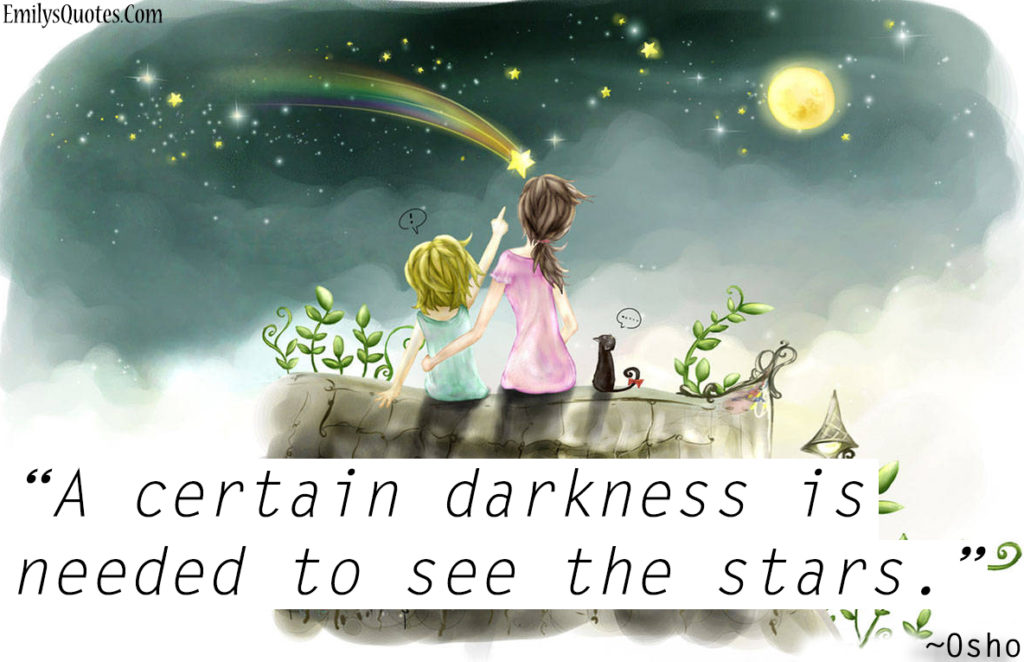Overcoming the fear of darkness

Overcoming the fear of darkness and discovering its qualities of rest, relaxation, and profound peace.
We have polluted our planet Earth with light. Light pollution – excessive and obtrusive artificial light, with bright neon and LED lights in our cities and in our personal space, continuously illuminated and artificial – has removed something incredibly valuable from our lives, and at the same time affected our ability to sleep, rest, and relax. ‘Falling in Love with Darkness’ is Osho’s attempt to bring us again in contact with darkness, but here in a spiritual and psychological context. ‘
Hankering for Light
‘Why do we desire light?,” he asks. ”Why do we hanker so much for light? Perhaps we never realize that the desire for light is a symbol of the fear rooted within us; it is a symbol of fear. We want light so that we can become free of that fear.” The mind is afraid in the dark. The fear of darkness is based on the fear of being alone: the fear of being alone comes together with the fear of darkness. Darkness has its own bliss; without falling in love with darkness, you will be deprived of the capacity to love the great truths of life. Next time you find yourself in darkness, take a direct look into it and you will discover that it is not so frightening after all.

Become One With Darkness
When darkness surrounds you, become absorbed in it, become one with it. And you will find that darkness offers you something that light can never give you. All the important mysteries of life are hidden in darkness. These are talks by Osho given at a meditation camp where he introduces people in a direct and practical way to an understanding of meditation as a way to get acquainted with darkness, to re-discover that darkness is peace, relaxation, and stillness, all through the simple method of witnessing. ”Meditation means: discovering the one who is beyond all happening and has never been a part of anything.”
Falling in love with Darkness: uitgave van 1969 voor ’t eerst in het Engels beschikbaar
Falling in Love with Darkness geeft het volgende te lezen. Als we snel online naar het woord “duisternis” zoeken, ontdekken we dat de media, de populaire cultuur en zelfs literaire bronnen ons overspoelen met beelden die angstideeën, somberheid, verschrikking en onheil oproepen en voorspellen. In andere woorden: bij de hele samenleving schijnt duisternis als een schrikbeeld voor  ogen te staan. Het wordt opgevat als alles waaraan mensen graag willen ontsnappen. In het boek “Falling in Love with Darkness” geeft Osho een radicaal andere overweging:
ogen te staan. Het wordt opgevat als alles waaraan mensen graag willen ontsnappen. In het boek “Falling in Love with Darkness” geeft Osho een radicaal andere overweging:
De duisternis is onbekend. We staan er alleen in. We voelen ons verloren en alles wat bekend en vertrouwd was, schijnt verdwenen te zijn. Maar houd dit vast: alleen mensen die kunnen beginnen op het pad van de waarheid – die het vermogen hebben om het vertrouwde te laten vallen, die bereid zijn om het bekende los te laten, die het onbekende binnen kunnen gaan waar er geen pad en geen spoor is – alleen zij kunnen de waarheid betreden. “Deze paar dingen spreek ik uit als een introductie omdat je zonder dat je van de duisternis gaat houden, de grote waarheden van het leven onthouden zullen worden.”
“Alle belangrijke mysteries van het leven liggen verborgen in de duisternis.”
“Als duisternis je omringt, laat haar dan totaal binnenkomen, word er één mee. En dan zul je ontdekken dat de duisternis je iets geeft wat licht je nooit kan opleveren.” Osho
Het boek ‘Falling in Love with Darkness’ is in de Nederlandse boekhandel te bestellen.
Hoofdstukken uit “FALLING IN LOVE WITH DARKNESS”
- Darkness is Peace, Relaxation
- Don’t Seek, Stop
- Darkness has no Existence
- From Dreams to Awakening
- Losing Suffering, Attaining Bliss
- Prayer is Love toward Existence
- Belief: the Greatest Obstacle in the Search for Truth
- Losing the Urge to Hurt Others
- Grasp the Knack of Meditation
- The Only Goal is Life Itself
Het boek “Falling in Love with Darkness” bevat een voorwoord van Osho, geciteerd uit zijn boek “The Rebel“. Het boek is een lezingenserie uit 1969 en is sinds 2017 voor het eerst beschikbaar in de Engelse taal.
Het boek heeft als ISBN 978-81-7261-342-6 is in Pune Osho International Meditation Resort verkrijgbaar en over enige tijd via internet.
FALLING IN LOVE WITH DARKNESS: IMPRESSION
A quick online search for the word “darkness” shows how the media, popular culture and even literary archives, are awash with images that trigger ideas of fear, gloom, horror, evil, and foreboding. In other words, the whole collective of society seems to be terrified of darkness. It is seen as everything that people would like to escape from. Here Osho presents a radical rethink:
“Darkness is unknown. We are alone in it. We feel lost and all that was known and familiar seems to have vanished. And remember, only people who can start the journey on the path of truth – who have the ability to let go of the familiar, who are ready to drop the known, who can enter the unknown where there is no path or track – only they can enter the truth.
“I am saying these few things as an introduction because without falling in love with darkness, you will be deprived of loving the great truths of life.”
“All the important mysteries of life are hidden in darkness.”
“When darkness surrounds you, become absorbed in it, become one with it. And you will find that darkness offers you something that light can never give you.” Osho
CHAPTERS of FALLING IN LOVE WITH DARKNESS
- Darkness is Peace, Relaxation
- Don’t Seek, Stop
- Darkness has no Existence
- From Dreams to Awakening
- Losing Suffering, Attaining Bliss
- Prayer is Love toward Existence
- Belief: the Greatest Obstacle in the Search for Truth
- Losing the Urge to Hurt Others
- Grasp the Knack of Meditation
- The Only Goal is Life Itself
The book Falling in Love with Darkness contains a foreword of Osho, quoted from his book “The Rebel“. The book is a lectures series from 1969 and since 2017 available in the English language.
ISBN 978-81-7261-342-6